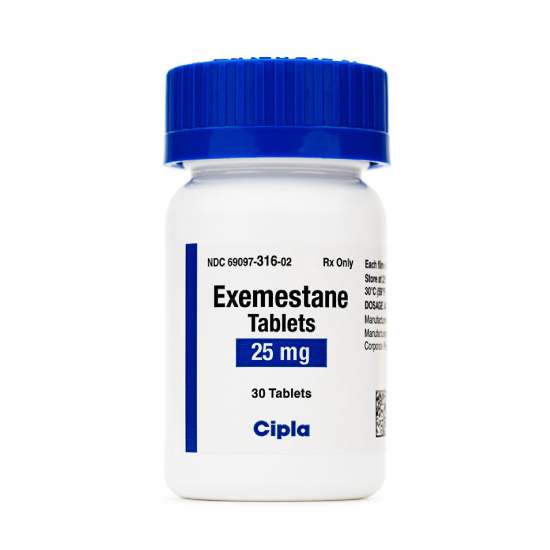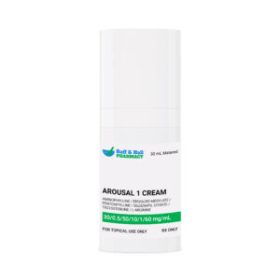This product is available solely through our 503A Compounding Pharmacy, ensuring personalized care and precision in every order. Please note that a valid prescription is required for purchase. If you do not have an account, please contact us.
Exemestane Tablet (Each) †
† commercial product
Exemestane is a type of aromatase inhibitor that can’t be undone. It is used in postmenopausal women as a treatment for advanced bone cancer and as an extra treatment for early-stage bone cancer that has estrogen receptors. One advantage of exemestane is that it doesn’t have cross-resistance with other aromatase inhibitors like anastrozole, letrozole, and tamoxifen. This means that patients whose cancer continues to grow while taking these other drugs may still respond to exemestane. Exemestane lowers estrogen levels more effectively than nastrozole or letrozole. When compared to megestrol in postmenopausal women with advanced bone cancer, exemestane had similar response rates, but it slowed the progression of the disease and improved survival. In patients with cancer that has spread to the lungs or liver, exemestane showed better overall response rates and longer survival. It also caused less weight gain compared to megestrol. The Intergroup Exemestane Study (IES) showed that switching to exemestane after 2 to 3 cycles of tamoxifen provided better disease-free survival than continuing tamoxifen for 5 cycles. The study was stopped early because exemestane showed significant improvements in disease-free survival after 30.6 months, with a relative risk reduction of 32% and an absolute risk reduction of 4.7%. . The best length of treatment and the most effective dose are not yet known. In October 1999, the FDA approved exemestane for the treatment of advanced breast cancer in postmenopausal women who had stopped responding to tamoxifen. In October 2005, exemestane was approved as an adjuvant hormonal treatment for postmenopausal women with estrogen receptor-positive early breast cancer. Specifically, women who have taken 2 to 3 cycles of tamoxifen can switch to exemestane to complete a total of 5 cycles of adjuvant hormonal treatment.
In clinical studies, some patients who take exemestane experience a decrease in bone density over time. This medication is linked to a higher risk of fractures compared to tamoxifen, although this increased risk is not statistically significant. Having osteoporosis or osteopenia before starting exemestane does not prevent someone from taking it, but it’s important to consider using bisphosphonates at the same time for those individuals. Anyone with existing osteoporosis, osteopenia, or risk factors for developing osteoporosis should have their bone density checked before beginning exemestane. During treatment with exemestane, watch for signs of osteoporosis, such as a drop in bone mineral density, and take action if needed. Right now, it’s unclear how combining exemestane with bisphosphonates affects bone density or fracture risk, and more research is being done on this.
Therefore, it’s important to check levels of 25-hydroxy vitamin D before starting exemestane. If a deficiency is found, begin vitamin D supplements.
Women who can get pregnant should avoid becoming pregnant while taking exemestane and for at least one month after the last dose.
While there are not enough studies in humans or animals to confirm this, exemestane can harm a developing fetus and may cause reproductive issues because of how it works. In animal studies, when rats were given 1 mg/kg of exemestane, the radioactive material from 14-C-exemestane and its metabolites passed through the placenta, leading to similar levels in the mother’s and fetus’s blood. When rats were given exemestane before mating and through pregnancy and nursing, an increase in placental weight was noted at about 1.5 times the recommended human dose. At 7.5 times the recommended dose, there were more miscarriages, fewer live fetuses, lower fetal weights, delayed bone development, longer pregnancies, and difficult births. At 210 times the recommended dose, along with maternal toxicity, there were abortions, increased miscarriages, and reduced fetal weight. No birth defects were observed in rats or rabbits at 320 and 210 times the recommended human dose, respectively.
It’s important to talk to patients about the risks of pregnancy and the need for contraception while on exemestane.
Women who can get pregnant should avoid becoming pregnant and use effective birth control during and or at least one month after treatment. Women who become pregnant while on exemestane should be made aware of the possible dangers to the fetus. Also, based on animal studies, exemestane might affect fertility in both men and women.
Because of the risk of serious side effects in babies from exemestane, women should stop breastfeeding while on the medication and for one month after their last dose.
Reductions in bone mineral density over time have been noted in patients on exemestane in clinical studies; exemestane treatment has been connected with an increased risk of fractures over tamoxifen—though a non-significant increased risk. Although pre-existing osteoporosis or osteopenia does not prohibit the use of exemestane, in these groups one should give thought to the simultaneous use of bisphosphonates. Before beginning exemestane treatment, patients with pre-existing osteoporosis, osteopenia, or risk factors for osteoporosis development should undergo formal bone mineral density analysis. As appropriate, examine patients for osteoporosis symptoms and indicators, including decreased bone mineral density (BMD), during treatment with exemestane. The effects of combined use of exemestane and bisphosphonates on bone mineral density and fractures is unknown right now; studies are now underway to determine those effects.
Early breast cancer patients frequently lack vitamin D; thus, before beginning exemestane treatment, determine 25-hydroxy vitamin D levels. Start vitamin D supplements for individuals lacking it.
1. Common Side Effects
⦁ Hot flashes
⦁ Fatigue
⦁ Headache
⦁ Joint/muscle pain
⦁ Nausea
⦁ Dizziness
⦁ Sweating/night sweats
⦁ Insomnia
⦁ Weight gain or increased appetite
⦁ Mood changes, depression
⦁ Hair thinning
2. Serious Adverse Effects
⦁ Osteoporosis/fractures (due to bone density loss)
⦁ Liver dysfunction (elevated liver enzymes, jaundice)
⦁ Cardiovascular risks (hypertension, chest pain, rare heart events)
⦁ Severe allergic reactions (swelling, rash, difficulty breathing – rare)
3. Laboratory Abnormalities
⦁ Increased liver enzymes (AST, ALT)
⦁ Elevated cholesterol
⦁ Low estrogen levels
4. Contraindications
⦁ Premenopausal women
⦁ Known hypersensitivity to exemestane or components
Gestation should be avoided by ladies of reproductive eventuality during treatment and for at least 1 month after the last cure. Although there are no adequately controlled studies in pregnant creatures or humans, exemestane can beget fetal detriment and is anticipated to affect in adverse reproductive goods because of its medium of action. In beast studies following oral administration of exemestane 1 mg/ kg, radioactivity related to 14- C- exemestane and its metabolites crossed the placenta of rats, with attention in motherly and fetal blood roughly original. When rats were given exemestane from 14 days prior to lovemaking until either days 15 or 20 of gravidity, and continuing for the 21 days of lactation, an increase in placental weight was seen at roughly 1.5 times the recommended mortal cure on a mg/ m2 base. Increased resorptions, reduced number of live fetuses, dropped fetal weight, retarded ossification, dragged gravidity, and abnormal or delicate labor was observed at roughly 7.5 times the recommended mortal cure on a mg/ m2 base. In rabbits, diurnal boluses of exemestane during organogenesis caused a drop in placental weight at 70 times the recommended mortal cure on a mg/ m2 base, and in the presence of motherly toxin, revocations, increased resorptions, and reduced fetal weight passed at 210 times the recommended mortal cure on a mg/ m2 base. Fetal deformations were n’t seen in rats or rabbits at roughly 320 and 210 times the recommended mortal cure on a mg/ m2 base, independently.
Due to the eventuality for serious adverse responses in nursing babies from exemestane, advise women to discontinue breastfeeding during treatment and for 1 month after the final cure. Exemestane is n’t indicated for premenopausal women and therefore should n’t be given to women who are bone- feeding their babies. It is n’t known if exemestane is excreted into mortal breastmilk; still, it has been detected in the breastmilk of creatures.
Store this medication at 68°F to 77°F (20°C to 25°C) and away from heat, moisture and light. Keep all medicine out of the reach of children. Throw away any unused medicine after the beyond use date. Do not flush unused medications or pour down a sink or drain.
- Coombes RC, Hall E, Gibson LJ, et al. A randomized trial of exemestane after two to three years of tamoxifen therapy in postmenopausal women with primary breast cancer. N Engl J Med 2004;350:1081-92.
- Winer EP, Hudis C, Burnstein HJ, et al. American Society of Clinical Oncology technology assessment on the use of aromatase inhibitors as adjuvant therapy for postmenopausal women with hormone receptor-positive breast cancer: status report 2004. J Clin Oncol 2005;23:619-29.
- Aromasin (exemestane) tablets package insert. New York, NY: Pfizer Inc; 2018 May
- Michaud LB. Adjuvant use of aromatase inhibitors in postmenopausal women with breast cancer. Am J Health-Syst Pharm 2005;62:266-73.





